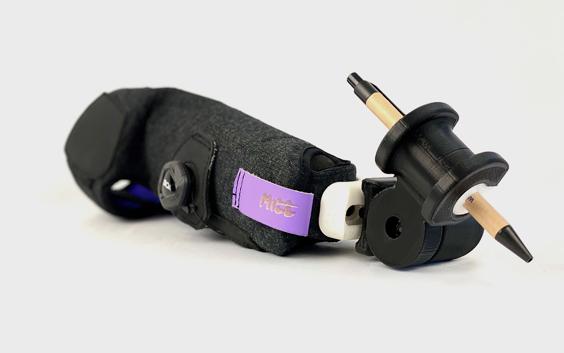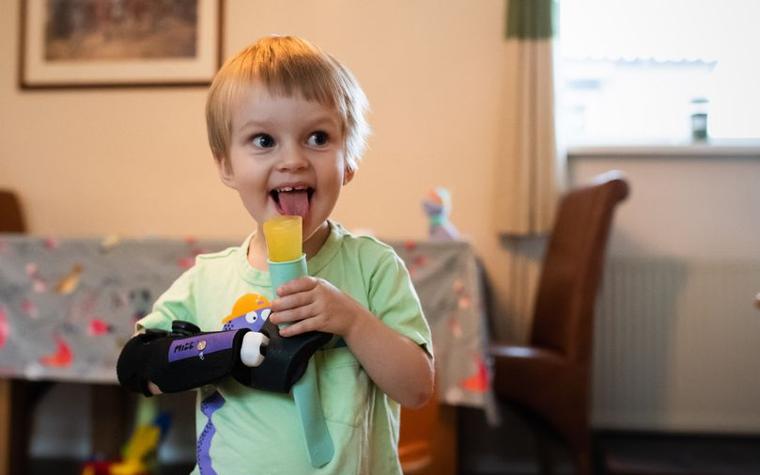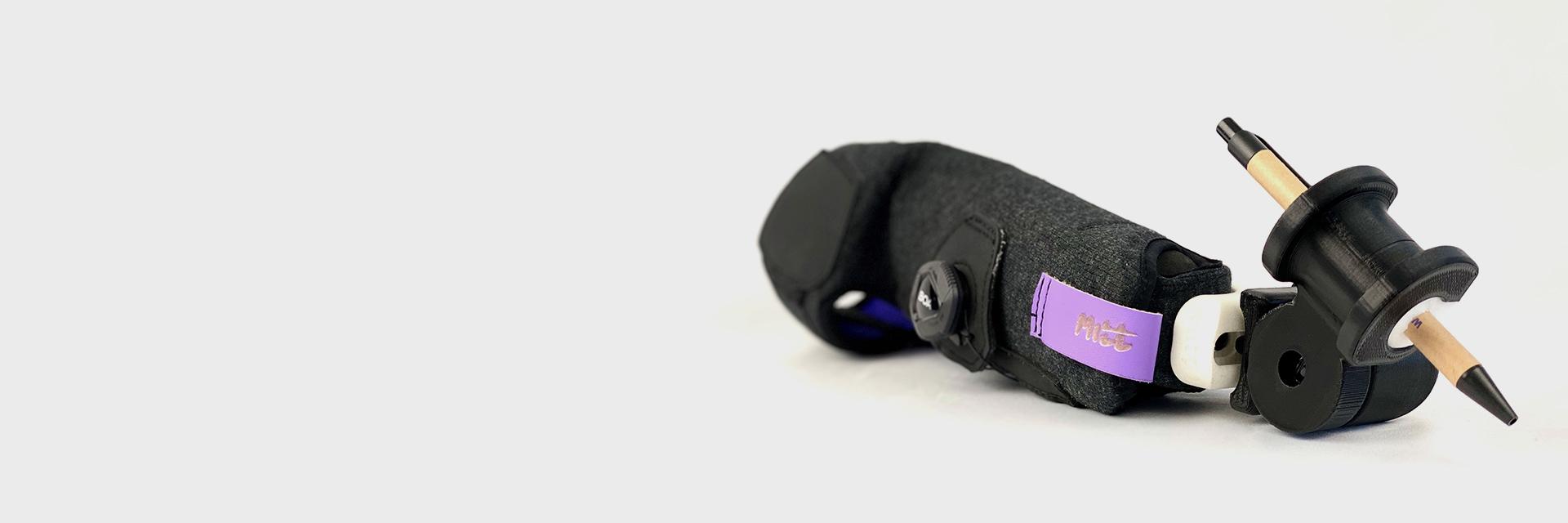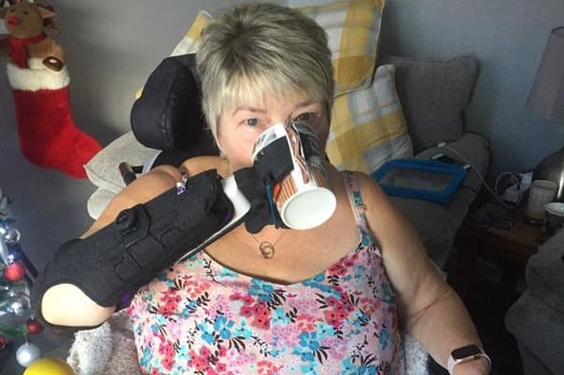CUSTOMER STORY
Mitt Brings Prosthetics within Reach Thanks to 3D Printing

Many traditional limb replacement options are too basic to be considered a real replacement, while at the other end of the spectrum, complex robotic limbs can present barriers in terms of learning and cost. By leveraging the design freedom 3D printing, UK start-up Mitt created a prosthetic arm that is not only highly functional, but is also comfortable, customizable, and accessible.
Influenced by the images we see on TV of incredible bionic limbs and Paralympic runners, it’s often hard to understand the reality of prosthetics for the average person living with limb loss. Traditional prosthetics are often too basic in function to be considered a truly practical replacement, while complex and costly robotic limbs are beyond the reach of most amputees.
To combat this, Mitt, a young start-up based in London, UK, asked Materialise to re-conceptualize what limb replacement really means. By putting function alongside form and leveraging the freedom of design that 3D printing offers, they’ve created a prosthetic arm that is functional, customizable, comfortable and, most importantly, accessible. And it’s this approach that saw them crowned Disrupter of the Year at this year’s London Business Awards.


Bridging the gap between WWII and Iron Man
The Mitt prosthetic was initially conceived as part of a thesis project by Founder Nate Macabuag and several classmates at Imperial College in London, United Kingdom. Early in their project, the team was introduced to a user of prosthetics, Alex Lewis. A quadruple amputee, Alex has used prosthetics to make incredible achievements, but when he showed the team the kind of product most amputees were given, they were stunned.
“This completely changed everything for us,” explains Nate, “meeting somebody who actually wears them and seeing that they’re big bits of plastic that still look like the exact same designs that were made in WWII.”
Somewhere in the gap between a rigid plastic socket with a hook on the end and the bionic features of movies like Iron Man, they felt there had to be a solution that could incorporate state-of-the-art technology, but without sacrificing the actual experiences of being human.
“We’re looking at prosthetics and we’re saying, if it’s something you wear, then truly, we should look at other things you wear and see how they do it. So we started building prosthetics like [we build] clothes and like shoes.”
— Nate Macabuag, Founder of Mitt
Working with Alex, they uncovered that the real problems with standard-issue prosthetics were actually rather simple. Prosthetic limbs are often very uncomfortable to wear and difficult to learn how to use. They’re also extremely expensive, with a single arm costing as much as £25,000 — an amount well out of reach for many amputees.
With this in mind, they decided to forgo the traditional approach of making something that mimicked a hand and get to the true root of what could make a prosthetic great.
Building prosthetics for function
Often the key to success in design is approaching a challenge from a unique perspective. Because the design team at Mitt are engineers rather than clinicians, their approach to the project started from a functional place and without pre-set ideas of what had come before. Knowing that with arms there’s not a lot of force going through them, the team determined that not all parts of the prosthetic needed to be rigid but that they also couldn’t take too much structure away or the product wouldn’t be useable.
“We’re looking at prosthetics and we’re saying, if it’s something you wear, then truly, we should look at other things you wear and see how they do it. We’re looking at clothes, looking at shoes, because you wear them all the time and they’re super comfy. So we started building prosthetics like clothes and like shoes,” says Nate.
But what really makes the Mitt unique, is the series of interchangeable tools that attach to the end of the arm. Rather than create something that looked like a hand for aesthetic reasons, they approached the design of this part with a straightforward question — what do you want to do with your arm? By focusing on the tasks that a person might do with their hand and their arm on a day-to-day basis, they could then envision the types of tools that could make a prosthetic truly useful and help people do specific tasks really well, and really simply.
“The way we use 3D printing, is for what it’s great for — rapid customizability. Because everyone has their own unique thing they want to do, we can make a really robust product that is also mass-customizable.”
— Nate Macabuag, Founder of Mitt
This led to the most unique tools in the Mitt arsenal, which is the LEGO attachment. Functional, but constructed purely for the joy of play. “Kids love it, I love it,” says Nate. “A lot of the healthcare industry is focused on what is functionally necessary for a human to eat and work. But there’s so much more to being a human than that. You just want to be able to do different things, you want to build an attachment because it’s cool, and I think that’s what makes it exciting.”
The choice of materials i.materialise offers also helps make customization a reality. All the Mitt attachments are currently made from plastic using selective laser sintering technology for its rigid and professional finish. However, if a user ever requested something that needed to have more force, while still remaining light, the flexibility exists with the technology to print parts out of both plastic and metal to ensure that it is strong where it needs to be, but that the weight won’t overwhelm the person using the tool.
The resulting product was a perfect merger of mechanical, fashion, and traditional product design. But a critical component to making it work — and making it accessible — was when they decided to incorporate 3D printing as the production method for their innovative tools.
Freedom of design and mass customization
After some initial experimentation with laser cutting, the Mitt team quickly realized its limitations when it came to freedom of shape. The ability to go from CAD to actual design and test out different iterations quickly by using 3D printing soon made the technology the cornerstone to production of the Mitts. With so many essential functions to address such as using a knife, holding a pen or gripping an object, not to mention things more purely for fun like using a racket, the team knew they needed a solution that wouldn’t limit the tools they could offer their customers.
"The way we use 3D printing, is for what it’s great for — rapid customizability. Because everyone has their own unique thing they want to do, we can make a really robust product that is also mass-customizable, which is super useful, especially in this kind of field. And this means the world is our oyster — we can put whatever we want on the end of one of our arms. Nate Macabuag, Founder of Mitt.
The tough part of designing a product that is both customizable and that needs to hold up to the stressors of everyday life, is testing your product to ensure it works the way it should over all foreseeable iterations. So when Mitt were looking to do their first big pilot test, they called on i.materialise to help with the project. The team wanted to test their Mitts across a full spectrum of potential users — infants all the way up to seniors, from across the UK — but they needed a large number of plastic components that would fix to the end of the arms and allow the different tools to be clipped in.
“Without i.materialise we couldn’t have done it. We just needed one component, but we needed a load of them, and i.materialise could do it out of really good, really strong materials and also really quickly, at a really good price,” says Nate.
The i.materialise platform was created to help people access professional 3D printing capabilities and a much wider range of materials than can be used in a home printer but without prohibitive costs. The Mitt team recognize that accessibility is the one of the largest barriers to people living with limb loss using prosthetics — 90% of people that could benefit from a prosthetic have no option to receive one simply as a result of where they live or because of financial reasons. Which is why they’ve set out to design a product that can be made, shipped and even adapted by its users easily, at a cost 100 times less than current standards of care.
A gold standard in prosthetic care
By thinking about prosthetics from the perspective of a user and harnessing the power of 3D printing technology, Mitt is setting out to create a new gold standard in prosthetic care. Their win at the London Business Awards is proof positive that this approach is working and is bringing awareness to a global unmet need with an exciting future.
Header image credit: Mitt ®
Share on:
You might also like
Never miss a story like this. Get curated content delivered straight to your inbox.


